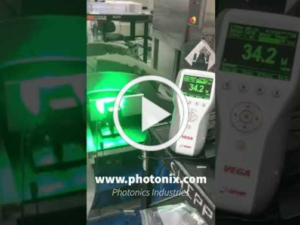Photonics Industries, the pioneer of intracavity solid-state harmonic lasers, new line of femtosecond (fs) pulse width lasers, FS Series, was recognized among the best by the 2022 Laser Focus World Innovators Awards by an esteemed and experienced panel of judges from the optics and photonics community.
Check out our latest video on the FS Series femtosecond laser: Photonics Industries ultrafast ruggedized lasers can withstand up to 3g of vibration while maintaining constant lasing and constant average power output, typical performance.
Photonics Industries’ FS Series femtosecond lasers offer the market the smallest, most compact, all-in-one (AIO) package coupled with high average powers (up to 100 W in IR, 55 W in GRN, 30 W in UV). In the ultrafast regime, the smaller fs pulse widths (~400 fs) expand applications still limited by ps or sub-ps pulse widths. The fs advantage spans from OLED processing (cutting, repair, etc.), to no-HAZ laser micromachining, and to nano/micro-structuring. Burgeoning research utilizing an industrial-type fs laser has also expanded the realm of many scientific applications.
Low, and variable fs pulse widths: < 350 fs to 20 ps specifiable range, high average powers: up to 100 W in a wide range of wavelengths: 1030 nm, 515 nm, 343 nm and 257 nm option on request are all available with an excellent TEM00 beam with typical M2 ~1.2
The smallest, most compact, AIO (i.e., no separate laser controller unit, utility module or umbilical cable needed) new revolutionary packaging has a smaller form factor and higher performance compared to other fs laser competitors on the market: 1/3 to 1/2 the volumetric size of leading competitors.
Pulse repetition rates range from single shot to 2 MHz, with option up to 40 MHz for processing at highest throughput with polygon scanners. The user-friendly control interface allows Total Pulse Control and Burst Mode operation, where a user selectable number of pulses with adjustable incremental separation and programable amplitude can be released in an envelope, further enabling ablation rate increases on many materials.
With adjustable repetition rate, the user can change the operating PRF and change the operating power or pulse energy through PEC (Power or Pulse Energy Control) function on the fly to maximize process flexibility.
Target applications for such lasers are:
- Ultrafast high precision cutting, drilling, welding, scribing, marking, intra-marking, patterning, depaneling with the smallest heat affected zone (HAZ)
- Flat Panel Display Repair, LCD/LED/OLED Repair
- Hydrophobic Material Manufacturing, Hydrophilic Material Manufacturing, Ultrafast Laser Assisted Etching (ULAE) Systems, Complex 3D Surface Micro-structuring
- Terahertz (THz) Generation, High Harmonic Generation (HHG), X-Ray Generation, OPO Amplifier Systems
- Laser Particle Accelerator Systems
- Angle/Time-resolved Photoemission Spectroscopy Systems, Femtosecond-stimulated Raman Spectroscopy (FSRS) Systems, Multi-photon Fluorescence Microscopy Systems





